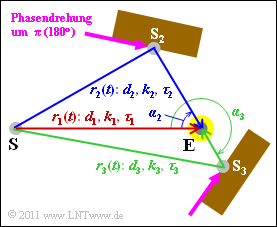Exercise 2.5Z: Multi-Path Scenario
In Task 2.5 a delay–Doppler–function was given. From this, we will calculate and interpret the other system functions. The given scatter function s(τ0,fD) was
- s(τ0,fD)=1√2⋅δ(τ0)⋅δ(fD−100Hz) −
- − 12⋅δ(τ0−1μs)⋅δ(fD−50Hz) −12⋅δ(τ0−1μs)⋅δ(fD+50Hz).
Note: In our learning tutorial, s(τ0,fD) is also identified with ηVD(τ0,fD) .
Here we have replaced the delay variable τ with τ0 . The new variable τ0 describes the difference between the delay of a path and the delay τ1 of the main path. The main path is thus identified in the above equation by τ0=0 .
Now, we try to find a mobile radio scenario in which this scatter function would actually occur. The basic structure is sketched above as a top view, and the following hold:
- A single frequency is transmitted fS=2 GHz.
- The mobile receiver (E) is represented here by a yellow dot. It is not known whether the vehicle is stationary, moving towards the transmitter (S) or moving away from it.
- The signal reaches the receiver via a main path (red) and two secondary paths (blue and green). Reflections from the obstacles cause phase shifts of π.
- S2 and S3 are to be understood here as fictitious transmitters from whose position the angles of incidence α2 and α3 of the secondary paths can be determined.
- Let the signal frequency be fS, the angle of incidence α, the velocity v and the velocity of light c=3⋅108 m/s. Then, the Doppler frequency is
- fD=v/c⋅fS⋅cos(α).
- The damping factors k1, k2 and k3 are inversely proportional to the path lengths d1, d2 and d3. This corresponds to the path loss exponent γ=2.
- This means: The signal power decreases quadratically with distance d and accordingly the signal amplitude decreases linearly with d.
Notes:
- This task belongs to chapter Das GWSSUS–Kanalmodell.
- We focus especially on the path-loss model and the Doppler effect.
Questionnaire
Sample solution
(2) The equation for the Doppler frequency is general or for the angle α=0.
- fD=vc⋅fS⋅cos(α),α=0:fD=vc⋅fS.
- This is what you get for speed:
- $$v = \frac{f_{\rm D}}}{f_{\rm S} \cdot c = \frac{10^2\,{\rm Hz}}}{2 \cdot 10^9\,{\rm Hz}} \cdot 3 \cdot 10^8\,{\rm m/s} = 15\,{\rm m/s} \hspace{0.1cm} \underline {= 54 \,{\rm km/h} \hspace{0.05cm}.$$
(3) Correct are the solutions 1 and 4:
- The Doppler frequency fD=50 Hz comes from the blue path, because the receiver somehow moves towards the virtual transmitter S2 (at the reflection point), although not in a direct direction.
- The angle α2 between the direction of movement and the connecting line S2–E is 60∘:
- \cos(\alpha_2) = \frac{f_{\rm D}}}{f_{\rm S}} \cdot \frac{c}{v} = \frac{50 \,{\rm Hz}\cdot 3 \cdot 10^8\,{\rm m/s}}}{2 \cdot 10^9\,{\rm Hz}\cdot 15\,{\rm m/s}} = 0.5 \hspace{0.3cm} \Rightarrow \hspace{0.3cm} \alpha_2
\hspace{0.1cm} \underline {= 60^{\circ} }
\hspace{0.05cm}.
(4) Correct are the statements 1 and 3:
- From fD=–50 Hz follows α3=α2±π, so α3 =240∘_.
(5) All statements are correct:
- The two Dirac functions at ±50 Hz have the same running time. For both durations τ3=τ2=τ1+τ0 is valid.
- From the same transit time, however, also follows d3=d2 and with the same length also the same damping factors.
(6) The runtime difference is τ0=1 µs, as shown in the equation for s(τ0,fD).
- This gives the difference in length:
- Δd=τ0⋅c=10–6s⋅3⋅108 m/s =300 m_.
(7) The path loss exponent was assumed to be γ=2 for this task.
- Then k1=K/d1 and k2=K/d2.
- The minus sign takes into account the 180∘–phase rotation on the secondary paths.
- From the weights of the Dirac functions one can read k1=√0.5 and k2=−0.5. From this follows:
- \2d1=k1−k2=1/√20.5=√2=1,414_.
- The constant K is only an auxiliary variable that does not need to be considered further.
(8) Aus d2/d1=2−0.5 and Δd=d2−d1=300 m finally follows:
- \sqrt{2} \cdot d_1 - d_1 = 300\,{\rm m} \hspace{0.3cm} \Rightarrow \hspace{0.3cm}
d_1 = \frac{300\,{\rm m}}}{\sqrt{2} - 1} \hspace{0.15cm} \underline {= 724\,{\rm m}}
\hspace{0.3cm} \Rightarrow \hspace{0.3cm} d_2 = \sqrt{2} \cdot d_1 \hspace{0.15cm} \underline {= 1024\,{\rm m}}
\hspace{0.05cm}.
